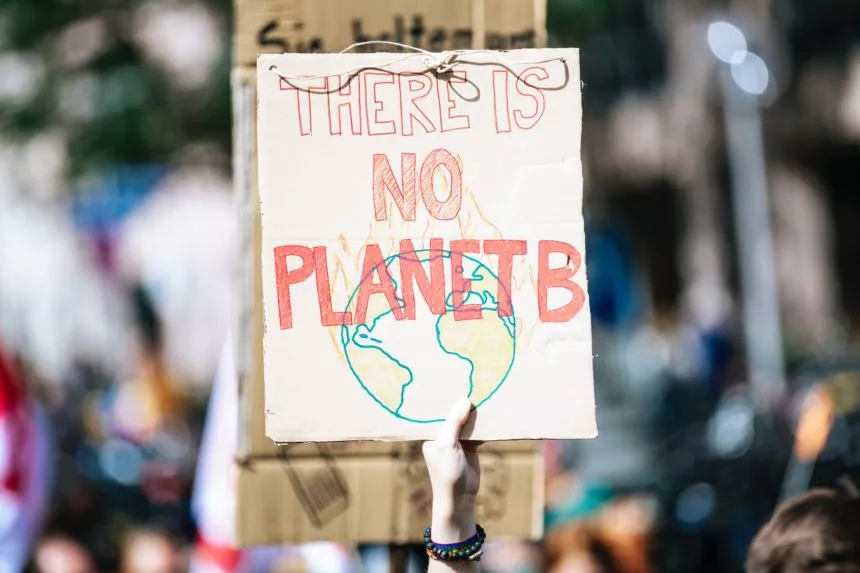New Imaginaries in Climate Change Innovation

Dr. Laura McKenzie is an ECR with an AHRC-funded Ph.D in English Literature from Durham University, where her research spanned the fields of classical reception and the medical humanities. She has held Visiting Fellowships at Harvard University and the Harry Ransom Center, Austin, and since completing her doctorate has worked in the space between academia and the subsidised arts, leveraging research to deliver outreach and engagement projects. She is currently completing a 12-month Research & Development Fellowship with Zinc, with support from the Arts and Humanities Research Council. You can read more about Zinc’s R&D activities here.
In a 2020 article on the role of art in the face of the climate crisis, Ben Okri contends that contemporary society finds itself in a position previously shared by few others (the Atlanteans, perhaps; more likely, if briefly, the Pompeiians). “It is not”, Okri charges, “given to many people to sense the end of time approaching.” It is a concept against which the mind struggles. We are not built for this type of “terminal contemplation” — something in us resists it. As a result, and despite the overwhelming amount of data telling us that we are accelerating towards devastation, the systems bringing human and non-human existence to their conclusions remain unchanged. The problem of the climate crisis, then, is partly a problem of imagination, and it is here that the humanities can intervene.
While climate change communication and policy are traditionally framed in scientific, data-driven terms, humanities perspectives are urgently needed to help interpret and give meaning to the profound transformation happening around us. If the climate crisis is also a crisis of the imagination, our approach to any solutions must marry the fine-grained critical work practiced by — for example — classicists, philosophers, and literary scholars with the more “applied” approach of “hard” social and natural sciences.
This work is already happening in the arts and academe. In Allegories of the Anthropocene (2019), UCLA’s Elizabeth M. DeLoughrey traces the ways in which indigenous and postcolonial peoples in the Caribbean and Pacific Islands grapple with the enormity of climate change and colonialism through art, poetry, and literature. Via these mediums, allegory is used as a means to understand the complexities of the climate crisis and, in particular, to critique the violence of capitalism, militarism, and the postcolonial state which has brought us to this point. These interrogations are vital. In its latest assessment report — released in April 2022 — the Intergovernmental Panel on Climate Change named colonialism as a historical and ongoing driver of the climate crisis, constituting an acknowledgement from policymakers and scientists that decolonisation must be intrinsic to the global response to climate change. The work of the authors and poets that Allegories of the Anthropocene engages with, such as Keri Hulme and Erna Brodber, have long been sounding the parameters and possibilities of this discourse. In doing so, as DeLoughrey points out, they are “catalysing new imaginaries” for our relationship to the natural world that are beyond the scope of the sciences alone.
So, what “new imaginaries” can the humanities bring to early stage innovation within the context of the climate crisis? We can return here to the problem of time, which our current trajectory requires us to consider in ways that, in Western thought at least, do not come naturally to us. We are programmed for short-termism, unable to fully imagine the effects of climate change a mere ten years from now, let alone think in the geological timescales that this challenge demands. To rise to it, we must learn instead to inhabit what Vincent Ilanti, author of Deep Time Reckoning (2020), calls “a longer now”.
Deep Time, which brings distant pasts and futures together within the present, is already shaping adaptation solutions: in Svalbard, biologists are storing seeds for a future in which vital plant species are extinct, while in Finland a new disposal site aims to safeguard radioactive waste for as long as it takes to cool (in the case of uranium-235, a mere seven hundred million years). These, however, are solitary bulwarks — Deep Time perspectives need to be applied to innovations that will disrupt the systems at the heart of the climate crisis. What ecological impacts will be precipitated by, for example, the soil degradation caused by the food and farming industries over the coming tens of thousands of years, and what can we do now to avert them? And what insights can ancient soil profiles, which enable scientists to reconstruct the Earth’s climate some fifty five million years ago, give us into possible solutions?
But thinking about time in this way is challenging. It warps our sense of belonging and disturbs our assumed relationships to the natural world. To locate humanity in Deep Time is to think of ourselves as a species, something for which there is no phenomenology. We can never experience ourselves as such, and can therefore make little sense of the fact that the lifespan for individual species is a mere two to ten million years, and that this is as applicable to us as to any non-human; that one day we will be part of the catalogue of ghosts that make up the story of life on our planet. As Shelley observed, when struck by the implacability of Mont Blanc, “the naked countenance of earth” bears witness as “All things that move and breathe with toil and sound / Are born and die; revolve, subside, and swell.”
Yet Deep Time is no abstraction: the humanities help us understand it as an intimate part of daily life that we encounter via hauntings and enchantments of all kinds. We tell Deep Time through stories, where it reworks notions of narrative, representation, and self. Take, for instance, Toni Morrison’s Beloved, which — with its critical neologism of “rememory” — insists on the fallacy of temporal distance, or Sophocles’ depiction, in Oedipus at Colonus, of a struggle for power over the future that will be decided (as is the case with nuclear waste) by the location of a burial site. Absent pasts renovate new presents. The distant future is telescoped by the prophetic eye.
Robin Wall Kimmerer, author of Braiding Sweetgrass (2013) and SUNY Professor of Environmental Biology, has written recently about strategies for persisting through climate change that centre Deep Time: “Mosses, I think, are like time made visible. They create a kind of botanical forgetting. Shoot by tiny shoot, the past is obscured in green. That’s why we have stories, so we can remember. The mosses remember that this is not the first time the glaciers have melted. […] If time is a circle, as the Indigenous worldview presumes, the knowledge we need is already within the circle; we just have to remember it to find it again and let it teach us. That’s where the storytellers come in.”
On the brink of environmental catastrophe, Kimmerer calls for storytellers; Okri, at the close of his article, calls for a visionary “re-dreaming” and an “existential creativity”. Deep Time and postcolonial imaginaries are just two ways into what must, at this precipice, be a meeting-space of science, innovation, and the humanities. It is this integration, which responds to and evokes the constantly evolving relationship between nature and culture, that will give us the tools required to repair it.
Join the Zinc community
Stay up to date with all Zinc updates and future posts as part of our fast growing community.
Featured Resources
Zinc Impact Report 2024
Zinc’s mission is to make the UK the best place to successfully start a venture which can have a massive impact on the health of people and the planet.
Increasingly, we are building deeper science ventures that serve global, industrial customers in environment and health, giving access to impact at a global scale.
Our 2024 Impact Report explores the challenges that need to be tackled to empower and enable talented founders from around the world to solve critical health and environmental challenges at scale, from here in the UK.
This report showcases success stories from the Zinc portfolio, and highlights how Zinc – and our growing community of hundreds of Founders, Fellows, Coaches, Partners and Funders – are working together to build a world-leading “Science-for-Impact” ecosystem for inception stage ventures in health and environment.
Impact Report 2023
We started Zinc with the hypothesis that missions are an effective way to attract highly ambitious, talented and experienced groups of innovators, who might not recognise themselves as “classic entrepreneurs” but are ready and able to start a new commercial and successful venture to tackle some of our most pressing societal issues.
The world has overcome the sorts of challenges we face today when it has adopted a mission-based approach to the biggest problems and brought together world-class talent to invent and innovate, e.g: NASA and landing a man on the moon, the LSE blueprinting the British welfare state, or the Gates Foundation aiming to eradicate diseases.
On this basis and assumption, we designed Zinc as a new mission-based Venture Builder — a place where global talent, ‘impact makers’, can join to experiment and develop new solutions to our most pressing societal issues.


